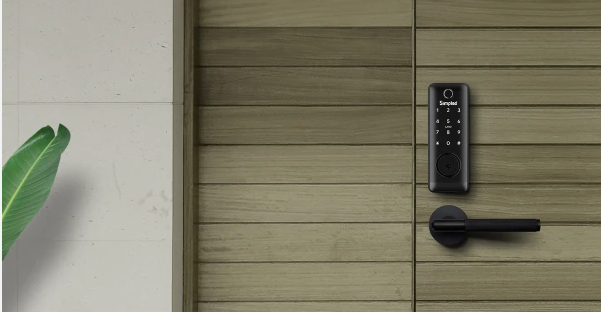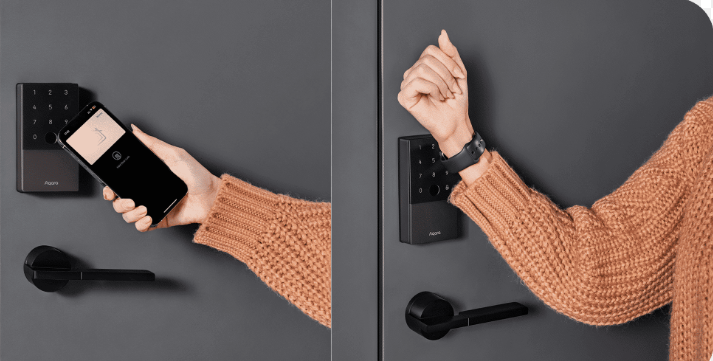Smart locks have revolutionized home security with their keyless entry, remote access, and smart home integration, but a common question persists: “Can smart locks be opened manually?” For many homeowners, the ability to open a smart lock manually, such as with a physical key, is a critical backup option in case of power or connectivity issues. In this detailed guide, we’ll explore whether smart locks can be opened manually, the different manual access methods, and how to ensure smart lock safety through proper smart lock installation, setup, and maintenance. By the end, you’ll understand how to choose a smart lock that offers reliable manual access and robust security for your home.
Understanding Smart Locks and Manual Access
Smart locks are advanced locking systems that allow keyless entry through methods like smartphone apps, PIN codes, biometric scans (e.g., fingerprints), or voice commands. They use technologies such as Wi-Fi, Bluetooth, Z-Wave, or Zigbee to connect with devices or smart home systems. While these digital features are convenient, situations like dead batteries, connectivity failures, or forgotten codes can make manual access essential.
The question “Can smart locks be opened manually?” is crucial for ensuring you’re never locked out of your home. Most smart locks are designed with manual access options to provide a failsafe, but the specifics vary by model. Let’s explore the different ways smart locks can be opened manually and how to maintain smart lock safety when using these methods.

Can Smart Locks Be Opened Manually? Exploring Access Options
Yes, most smart locks can be opened manually, typically through a physical key or other non-digital methods. These manual access options ensure you can enter your home even if the smart features fail. Here are the primary ways smart locks can be opened manually:
- Physical Key Backup: Many smart locks include a traditional key cylinder, allowing you to use a physical key to lock or unlock the door. Brands like Schlage, Yale, and Kwikset often include a key slot on the exterior portion of the lock, blending traditional and smart functionality.
- Manual Override Knob or Lever: Some smart locks feature a thumb-turn or knob on the interior side of the door, allowing you to manually lock or unlock from inside without digital input. This is common in deadbolt-style smart locks.
- Backup Power Options: If a smart lock’s batteries die, some models offer a temporary power solution, such as a 9V battery terminal or USB port, to restore functionality long enough to open the door. While not strictly “manual,” this method allows access without connectivity.
- Mechanical Keypad or Dial: Certain smart locks, especially those without connectivity (e.g., offline PIN code locks), rely on a mechanical keypad or dial for manual entry. These don’t require power or an app, making them a reliable manual option.
While most smart locks offer at least one manual access method, some models—particularly retrofit or portable smart locks—may not include a physical key, relying instead on alternative backups like a keypad or backup power. Always check the lock’s specifications in a trusted best smart lock guide to confirm manual access options before purchasing.
Benefits of Manual Access for Smart Locks
The ability to open a smart lock manually provides several advantages, enhancing both convenience and reliability:
- Reliable Backup: A physical key or manual override ensures access during power outages, dead batteries, or connectivity issues, preventing lockouts.
- Peace of Mind: Knowing you can open your smart lock manually offers reassurance, especially in emergencies or when technology fails.
- Flexibility for All Users: Manual access is ideal for household members or guests who may not have access to the lock’s app or codes.
- Enhanced Security: A high-quality physical key cylinder (e.g., with pick-resistant technology) complements the lock’s digital security, maintaining smart lock safety.
These benefits make manual access a critical feature for many users, particularly those prioritizing reliability.
Challenges and Considerations for Manual Access
While manual access is a valuable feature, there are challenges and considerations to keep in mind to ensure smart lock safety and functionality:
- Key Security: If your smart lock includes a physical key, it’s vulnerable to traditional risks like key duplication or loss. Store the key securely and avoid leaving it in obvious places.
- Limited Manual Options: Some smart locks, especially retrofit or portable smart locks, may not include a physical key, relying solely on backup power or keypads. Verify the manual access options before buying.
- Mechanical Wear: The physical components of a smart lock, like the key cylinder or thumb-turn, can wear over time, especially with frequent use. Regular smart lock maintenance is essential to keep these components functional.
- Installation Issues: Improper smart lock installation can affect the manual override mechanism, such as misalignment of the key cylinder or bolt. Ensure proper installation to avoid issues.
By addressing these challenges through careful selection and maintenance, you can ensure reliable manual access for your smart lock.
How to Ensure Reliable Manual Access for Your Smart Lock
To maximize the reliability of your smart lock’s manual access and maintain smart lock safety, follow these best practices for smart lock installation, setup, and maintenance:
1. Choose a Smart Lock with Manual Access Options
Select a smart lock that offers a physical key or other manual override methods, especially if you prioritize backup access. Check the lock’s specifications or consult a comprehensive smart lock guide to confirm it includes a key cylinder or mechanical override suited to your needs.
2. Perform Proper Smart Lock Installation
Correct smart lock installation is crucial for ensuring the manual components (e.g., key cylinder or thumb-turn) work smoothly. Follow these steps:
- Verify your door’s compatibility, including thickness (typically 1-3/8 to 1-3/4 inches) and bore hole sizes (2-1/8-inch for the lock body, 1-inch for the latch).
- Follow the manufacturer’s installation instructions carefully, ensuring the key cylinder and bolt are properly aligned with the strike plate.
- Test the physical key and manual override after installation to confirm smooth operation.
- If installing on a metal or thick door, ensure the lock supports the door’s specifications, as misalignment can affect manual access.
Tip: If you’re unsure about installation, hire a professional locksmith to ensure the manual components are correctly fitted.
3. Secure Your Smart Lock Setup
While manual access is a backup, the digital features of your smart lock still require secure configuration to maintain overall smart lock safety. During smart lock setup:
- Use a strong, unique password for the lock’s app and any associated smart home accounts.
- Enable two-factor authentication (2FA) to protect digital access.
- Connect your smart lock to a secure Wi-Fi network with WPA3 encryption, if applicable.
- Follow the manufacturer’s instructions for how to pair a smart lock to ensure secure device connections.
4. Monitor Smart Lock Battery Life
A dead battery is a common reason you might need to rely on manual access. Most smart locks have a smart lock battery life of 6–12 months, but Wi-Fi-enabled locks may drain faster. To prevent lockouts:
- Check the battery level every 3–6 months via the lock’s app.
- Replace batteries promptly when low, using high-quality AA or AAA batteries as recommended.
- Look for models with backup power options (e.g., 9V terminal or USB port) for emergency access.
5. Perform Regular Smart Lock Maintenance
Regular smart lock maintenance ensures both digital and manual components remain reliable:
- Lubricate the key cylinder and bolt periodically to prevent sticking, using a graphite-based lubricant recommended for locks.
- Clean the lock and keypad to remove dirt or debris, especially on exterior doors.
- Update the lock’s firmware via its app to address software issues that could affect performance.
- Test the physical key and manual override regularly to ensure they function smoothly.
6. Troubleshoot Manual Access Issues
If the manual access method (e.g., physical key or thumb-turn) doesn’t work, use the manufacturer’s smart lock troubleshooting guide to diagnose the issue:
- Key Issues: Ensure the key is not bent or damaged. If it doesn’t turn smoothly, check for misalignment or debris in the cylinder.
- Thumb-Turn Problems: If the interior knob or lever is stuck, inspect for mechanical obstructions or loose components.
- Backup Power Failure: If using a 9V battery or USB backup, ensure proper contact and try a fresh battery.
- Professional Help: If manual access remains unreliable, contact the manufacturer or a locksmith for assistance.
7. Consider a Portable Smart Lock for Flexibility
For renters or those who prefer non-permanent solutions, a portable smart lock can be an excellent choice. These locks often attach to the interior side of the door without requiring a key cylinder, relying instead on a keypad or app for manual access. Ensure the portable lock is compatible with your door and offers reliable backup options.

Smart Lock Use Cases and Manual Access
The need for manual access varies depending on your use case. Here’s how manual options apply to different scenarios:
- Homeowners: Choose a smart lock with a physical key for exterior doors to ensure access during power or connectivity failures.
- Renters: A portable smart lock with a keypad or mechanical override is ideal for apartments, as it avoids permanent modifications.
- Vacation Rentals: Smart locks with physical keys or backup power options ensure hosts and guests can access the property if digital features fail.
- Businesses: Commercial-grade smart locks with manual overrides provide reliable access for employees, especially in high-traffic settings.
Common Myths About Smart Locks and Manual Access
Several misconceptions about smart locks and manual access can cause confusion. Let’s debunk a few:
- Myth: Smart locks can’t be opened manually. Most smart locks include a physical key, thumb-turn, or backup power option for manual access.
- Myth: Manual access makes smart locks less secure. High-quality key cylinders and secure smart lock setup ensure manual access doesn’t compromise safety.
- Myth: Smart locks always fail without power. Manual overrides and backup power options ensure access even during battery or power failures.
By choosing a reliable smart lock and following proper smart lock tips, you can ensure manual access is both convenient and secure.
Conclusion: Can Smart Locks Be Opened Manually?
So, can smart locks be opened manually? Yes, most smart locks offer manual access options, such as a physical key, thumb-turn, or backup power, ensuring you’re never locked out due to battery or connectivity issues. By selecting a compatible model with reliable manual access and following best practices for smart lock installation, smart lock setup, and smart lock maintenance, you can enjoy the convenience of smart technology with the peace of mind of a manual backup. Regular monitoring of smart lock battery life and prompt smart lock troubleshooting will keep both digital and manual features running smoothly.
For help finding a smart lock with robust manual access options, explore this comprehensive home security tips guide to discover models that balance security, convenience, and reliability for your home.